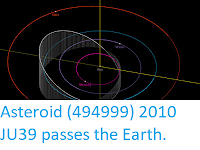Asteroid 2019 OD passed by the Earth at a distance of about 357 840
km (0.93 times the average distance between the Earth and the Moon, or 0.24% of the distance between the Earth and the Sun), slightly after 1.30 pm
GMT on Wednesday 24 July 2019. There was no danger of
the asteroid hitting us, though were it to do so it would have
presented a significant threat. 2019 OD has an estimated
equivalent
diameter of 38-120 m (i.e. it is estimated that a spherical object
with
the same volume would be 38-120 m in diameter), and an object at the
upper end of this range would be predicted to be capable of
passing through the Earth's
atmosphere relatively intact, impacting the ground directly with an
explosion that would be about 20 000 times as powerful as the
Hiroshima
bomb. Such an impact would result in an impact crater over 1.5 km
in
diameter
and devastation on a global scale, as well as climatic effects that
would last years or even decades.
Close approach of Asteroid 2019 OD to the Earth on 24 July 2019. The green line indicates the object's apparent motion relative to the Earth, and the bright green
marks are the object's location at approximately half hour intervals. The Moon's orbit is
grey. The blue arrow points in the direction of Earth's motion and the yellow arrow points
toward the Sun. Minor Planet Center.
2019 OD was discovered on 21 July 2019 (three days before its closest approach to the Earth) by the Atlas MLO Telescope at Mauna Loa Observatory in Hawaii. The designation 2019 OD implies that the asteroid was the fourth object (object D -
in numbering asteroids the letters A-Z, excluding I, are assigned
numbers from 1 to 25, so that D = 4) discovered in the second half of July 2019 (period 2019 O).
2019 OD
has an 1347 day orbital period and an eccentric orbit
tilted at an angle of 0.82° to the plane of the Solar System, which
takes it from 0.68 AU from the Sun (i.e. 68% of he average distance at
which the Earth orbits the Sun, and slightly inside the orbit of the planet Venus) to 4.09 AU from the Sun (i.e. 409% of
the
average distance at which the Earth orbits the Sun, and somewhat more
than twice the orbit of the planet Mars). It is
therefore
classed as an
Apollo Group Asteroid (an asteroid that is on average further from the
Sun than the Earth, but which does get closer). This means that close
encounters between the asteroid and Earth are common, with the
last having occurred in July 2008 and the next predicted
in August 2020
The calculated orbit of 2019 OD. JPL Small Body Database.
2010 OD also
has frequent close encounters with the planets Venus, which it last
came close to in February 1946 and is next predicted to
pass in April 2056, Mars, which it is predicted to pass again in May 2038, and Jupiter, which it last
came close to in August 2017
and
is next predicted to pass in December 2028. Asteroids
which make close passes to multiple planets are considered to be in
unstable orbits, and are often eventually knocked out of these orbits by
these encounters, either being knocked onto a new, more stable orbit,
dropped into the Sun, knocked out of the Solar System or occasionally
colliding with a planet.
See also...
Follow Sciency Thoughts on Facebook.








